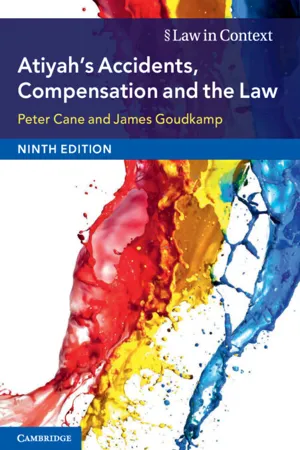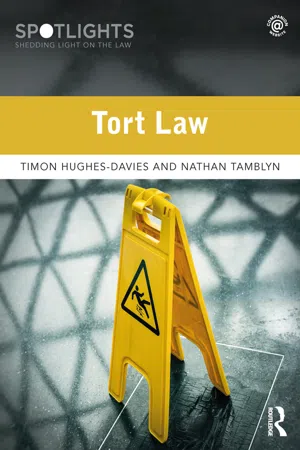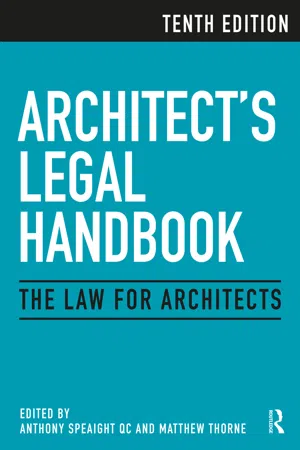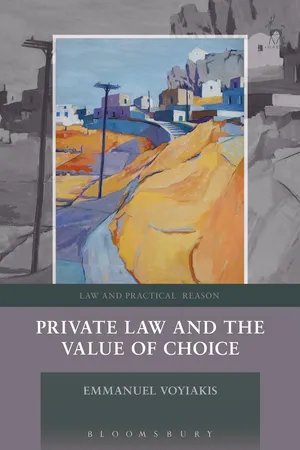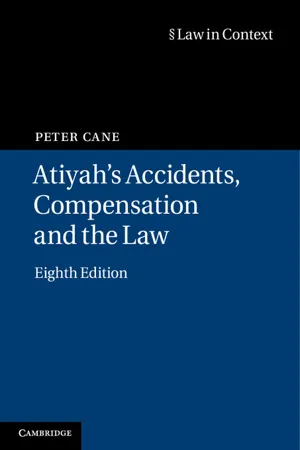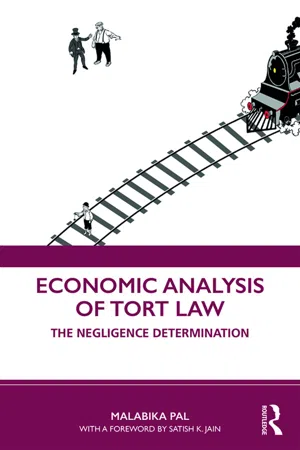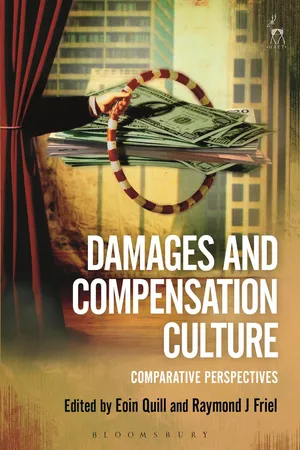Law
Contributory Negligence
Contributory negligence is a legal concept that holds individuals partially responsible for their own injuries or damages if they are found to have contributed to the situation through their own negligence. In cases where contributory negligence is proven, the individual's compensation or damages may be reduced in proportion to their level of fault. This principle is used in determining liability in legal disputes.
Written by Perlego with AI-assistance
Related key terms
1 of 5
12 Key excerpts on "Contributory Negligence"
- eBook - PDF
- Peter Cane, James Goudkamp(Authors)
- 2018(Publication Date)
- Cambridge University Press(Publisher)
2.5.1.3 The Assessment of Contributory Negligence The principle of reducing damages for Contributory Negligence may appear to be based on a simple idea about personal responsibility. However, the way the claimant’s damages are reduced is, in a sense, far from obvious or straight- forward. Instead of the extent of the reduction being determined simply by reference to the degree of the claimant’s fault, the courts take cognizance of two factors, namely, the degree of the claimant’s fault relative to that of the defendant along with the ‘causal potency’ of the parties’ respective acts. 45 In addition, just as the amount of compensation a negligent defendant must pay bears no relation to the degree of his or her fault where he or she alone is to blame (7.1), so also the amount of the loss that the claimant must bear when partly at fault depends not just on the extent of that fault, but also on the extent of the loss itself. Let us consider how all this works with a few illustrations. First, a claimant who is 50 per cent to blame for an accident in which they suffer a loss assessed at £10,000 will lose £5,000 as a result of their negligence. A claimant who is a mere 10 per cent to blame for an accident in which the loss is assessed at £100,000 will lose £10,000 as a result of their negligence. Secondly, a motorist who commits a trivial act of negligence and collides with a defendant who was driving with gross negligence will be held perhaps 10 per cent to blame; but the motorist (guilty of the same trivial act of negligence) may be held 50 per cent to blame if the defendant was no more negligent than the claimant. Yet the claimant’s act of negligence is precisely the same in the two cases. - eBook - ePub
- Timon Hughes-Davies, Nathan Tamblyn(Authors)
- 2019(Publication Date)
- Routledge(Publisher)
The second part of this chapter looks at the remedies available in negligence. Historically, the only remedy which a common law court could award was damages, and this remains the main remedy. Awarding compensation for the harm caused requires, in the case of personal injury, the court to put a price on the value of an injury, and this chapter sets out how the court determines what is a fair amount for the defendant to pay if he or she has, for example, caused a serious head injury or a broken leg. Claimants can also recover any financial costs caused by the personal injury, such as the loss of earnings and future care costs.Other remedies include court orders, or injunctions, to make the defendant do something or to prevent him or her from doing something. These are rarely used in negligence, but are commonly granted in other torts, such as trespass to land.____________As you read
- Understand the defences of Contributory Negligence, voluntary assumption of risk and illegality, and the circumstances in which they apply.
- Understand the remedies available in negligence, and the principles on which they are awarded.
9.2 Contributory Negligence
Contributory Negligence can be pleaded by the defendant where the claimant’s own actions have contributed to the harm caused: where the claimant has failed to take reasonable care for his or her own well-being, and that lack of care is one of the factors that has caused the damage, the claimant is contributorily negligent. The claimant’s lack of care may contribute to the incident causing the damage, or it may make the damage more severe.Key learning point
Contributory Negligence is a defence where the claimant’s failure to take reasonable care for his or her own safety:- was one of the factors causing the incident; or
- did not cause the incident, but did contribute to the severity of the injury.
Contributory Negligence was, until 1945, a complete defence. If the claimant was partially responsible for the injury that he or she suffered, then the defendant was not liable for causing the injury. This was particularly significant in industrial injuries, where an employer, by showing that the worker had not taken reasonable care for his or her own safety and had substantially contributed1 to the harm caused, could completely avoid any obligation to compensate the worker. In Lewis v Denye,2 - eBook - PDF
Measuring Damages in the Law of Obligations
The Search for Harmonised Principles
- Sirko Harder(Author)
- 2010(Publication Date)
- Hart Publishing(Publisher)
9 Contributory Negligence in Tort The claimant may contribute to the occurrence of the defendant’s wrong or the ensuing loss by acting unreasonably. Unreasonable behaviour occurring once the claimant is aware of the wrong is addressed through the mitigation principle, according to which the claimant cannot recover for loss that she could have avoided by taking reasonable steps. 1 Unreasonable behaviour prior to that date is called Contributory Negligence. At common law, Contributory Negligence is a complete defence to many torts. For this reason, some textbooks on damages leave the issue out on the ground that it relates to the existence rather than the extent of liability. 2 However, the Law Reform (Contributory Negligence) Act 1945 replaced the complete defence with a proportionate reduction in the damages. The issue of Contributory Negligence has thus become a proper part of the law of damages. It features in most textbooks on damages 3 or remedies in general. 4 I The Position Apart from the 1945 Act Even though the effect of Contributory Negligence in tort is almost entirely governed by the Law Reform (Contributory Negligence) Act 1945, a glance at the position apart from that Act is necessary to understand the thrust of the Act and its references to the common law. Usually, the position apart from the 1945 Act is described in the past tense, suggesting a ‘ freezing’ of the common law at its state in 1945. But there is 1 Below ch 10, VI C. 2 SM Waddams, The Law of Damages , 3rd edn (Toronto, 1997) [15.20]. The issue is also left out by H Street, Principles of the Law of Damages (London, 1962). 3 H McGregor, McGregor on Damages , 18th edn (London, 2009) ch 5; AI Ogus, The Law of Damages (London, 1973) 103–107. 4 A Burrows, Remedies for Torts and Breach of Contract , 3rd edn (Oxford, 2004) 129–44; D Harris, D Campbell and R Halson, Remedies in Contract and Tort , 2nd edn (London, 2002) 86–87, 308–309, 578. 129 - eBook - PDF
Law and Economics
An Introductory Analysis
- Werner Z. Hirsch(Author)
- 2014(Publication Date)
- Academic Press(Publisher)
As mentioned earlier, both orthodox and modified contributory negli-gence are affirmative defenses that are traditionally afforded by tort law. The defense of Contributory Negligence had a long history. It entered English law in the beginning of the nineteenth century; 33 Brown v. Ken-dall introduced Contributory Negligence as an integral part of American negligence doctrine in 1850. 34 32 Ibid.: 330-331. ^Butterfield v. Forrester, 103 Eng. Rep. 926 (K. B. 1809). 34 Brown v. Kendall, 60 Mass. (6 Cush.) 292, 296 (1850). 182 6 TORT LAWS BASIC LEGAL PREMISES (α) X* (c) λ (e r* s) X X X r r Y > -< ;*, X (b) X (d) x* * (f) FIGURE 6-1 Liability rules: (a) no liability; (b) strict liability; (c) the negligence rule; (d) strict liability with Contributory Negligence; (e) the negligence rule with contributory negli-gence; (f) strict liability with dual Contributory Negligence; and (g) relative negligence. The shaded areas indicate where the injurer is liable when X represents the effort of the injurer to prevent harm; Y, the effort of the victim to avoid harm; X*, the legal standard of negligence for the injurer; F*, the legal standard of negligence for the victim; and Ω, the optimum amount of protection. (From J. P. Brown, Toward an Economic Theory of Liability, Journal of Legal Studies, (June 1973): 330-331. By permission.) Let us examine the contributory-negligence rule and some of its com-plications. Assume a $100 risk that the defendant could prevent for $80, but that the plaintiff could prevent for $10. Although the defendant may be negligent, the plaintiff is more efficient in preventing the acci-dent. The economic justification of the rule is to give the plaintiff an incentive to spend his $10, since he is the most efficient accident pre-venter. Complications arise when we reverse the numbers. Now the plaintiff can prevent the risk for $80 and the defendant for only $10. - No longer available |Learn more
Architect's Legal Handbook
The Law for Architects
- Anthony Speaight QC, Anthony Speaight QC, Matthew Thorne, Anthony Speaight QC, Matthew Thorne(Authors)
- 2021(Publication Date)
- Routledge(Publisher)
Claimants are under a duty in tort to take reasonable care of their own safety. If the claimant is the only cause of the damage, then he or she will not succeed in a tortious action against another person. If the claimant and one or more other persons are at fault, then damages are apportioned, pursuant to the Law Reform (Contributory Negligence) Act 1945, according to the court’s assessment of the relative degree of fault of the parties. 11.02 In assessing this relative responsibility, the court considers both the causative potency of the parties’ actions (i.e. how important was each party’s role as a matter of fact to the ensuing damage) and their relative moral blameworthiness (for example, if one party to a road traffic accident is drunk at the time, that party is likely to be apportioned more of the blame). Contributory Negligence applies to liability in negligence, nuisance, the rule in Rylands v Fletcher, trespass, under the Occupier’s Liability Acts, and other breaches of statutory duty. 11.03 Further, section 1 of the Civil Liability (Contribution) Act 1978 provides: Subject to the following provisions of this section, any person liable in respect of any damage suffered by another person may recover contribution from any other person liable in respect of the same damage (whether jointly with him or otherwise). 11.04 Thus, between themselves, defendants are also able to apportion blame and restrict their relative contribution to the claimant’s damages. This may take the form of an apportionment of blame at the trial of the matter or the commencement of separate proceedings (called Part 20 proceedings) by a defendant against another party who is said to be jointly or wholly to blame - eBook - PDF
- Emmanuel Voyiakis(Author)
- 2017(Publication Date)
- Hart Publishing(Publisher)
For that argument, see G Schwartz, ‘Contributory and Comparative Negligence: A Reappraisal’ (1978) 87 Yale LJ 697, 722: ‘the conduct that establishes Contributory Negligence cannot be regarded as egoistical or antisocial; instead it is behavior that, from the actor’s or others’ perspective, is merely foolish or stupid. This assessment undermines the supposed moral parity between the “fault” of negligence and the “fault” of Contributory Negligence.’ the protection principle being the obvious candidate for that role. Alternatively, if those models purport to account only for burdens of repair, they will have to say either that they offer a partial account of private law, or that Contributory Negligence falls outside private law’s domain. The following passage on Contributory Negligence, by Allan Beever, illus-trates another aspect of the same problem: The claimant owes no duty of care to herself and, in committing Contributory Negligence, usually does not breach any duty to the defendant. Hence, when the defendant alleges that the claimant was contributorily negligent, he does not allege that the claimant committed a wrong. Rather, he alleges that the claimant’s lack of reasonable care undercut’s the claimant’s case against him, because the claimant’s lack of care is as significant as his own in evaluating the relationship between the parties. 35 A version of that idea appears in the US Third Restatement of Torts, which reads: Plaintiff ’s negligence same as defendant’s negligence : the distinction between imposing risks on oneself and imposing risks on others is not a good reason to distinguish between the standard employed to evaluate a plaintiff ’s conduct and a defendant’s conduct. It merely is a reason to distinguish between risk to self and risk to others, whether imposed by a plaintiff or defendant. This Section provides merely that plaintiffs and defendants are evaluated symmetrically, whatever distinctions are drawn between risks to self and risk to others. - eBook - PDF
- Peter Cane(Author)
- 2013(Publication Date)
- Cambridge University Press(Publisher)
2.5.1.3 The assessment of Contributory Negligence Even though the principle of reducing damages for Contributory Negligence may appear to be based on a simple idea about personal responsibility, the way the claimant’s damages are reduced is far from obvious or straightforward. The claimant’s damages will be reduced having regard not just to the degree of his or her fault – whether that be slight or gross – but according to the degree of the claimant’s fault relative to that of the defendant. In addition, just as the amount of compensation a negligent defendant must pay bears no relation to the degree of his or her fault where he or she alone is to blame, so also the amount of the loss which the claimant must bear when partly at fault depends not just on the extent of that fault, but also on the extent of the loss itself. Let us consider how all this works with a few illustrations. First, a claimant who is 50 per cent to blame for an accident in which they suffer a loss assessed at £10,000 will lose £5,000 as a result of their negligence. A claimant who is a mere 10 per cent to blame for an accident in which the loss is assessed at £100,000 will lose £10,000 as a result of their negligence. Secondly, a motorist who commits a trivial act of negligence and collides with a defendant who was driving with gross negligence will be held perhaps 10 per cent to blame; but the motorist (guilty of the same trivial act of negligence) may be held 50 per cent to blame if the defendant was no more negligent than the claimant. Yet the claimant’s act of negligence is precisely the same in the two cases. - eBook - ePub
Economic Analysis of Tort Law
The Negligence Determination
- Malabika Pal(Author)
- 2019(Publication Date)
- Taylor & Francis(Publisher)
1 Introduction Negligence is a central concept in tort law. It has been widely accepted that as a matter of doctrine, the expansion of liability in modern tort law took place within the framework of the concept of negligence. Broadly, “negligence” refers to the failure of an actor to take reasonable care to prevent harm caused by the actor’s conduct. 1 One close contender for being the fundamental tort principle is strict liability. It refers to liability imposed on an actor for harm the actor causes, whether or not the actor is negligent. 2 The concept of “fault” includes negligence and intentional wrongful infliction of harm on others. With respect to only unintentional torts, with which this study is concerned, the concept of fault becomes synonymous with negligence. According to the Restatement (Third) of Torts, the overarching and unifying normative principle of American tort law is fault. Although pockets of strict liability exist, unlike negligence, no overarching principle unifies them in an effective and coherent whole. 3 The rule of negligence with the defense of Contributory Negligence was the dominant rule of tort law not only in America but also in most common law jurisdictions since its inception into English law in the case of Butterfield v Forrester 4 in 1809 and its espousal in the leading American case of Brown v Kendall. 5 In the latter case, the defendant took up a stick to separate fighting dogs belonging to the plaintiff and the defendant and during the attempt accidently hit the plaintiff in the eye, injuring him severely - eBook - PDF
- Andrew Dyson, James Goudkamp, Frederick Wilmot-Smith, Andrew Dyson, James Goudkamp, Frederick Wilmot-Smith(Authors)
- 2017(Publication Date)
- Hart Publishing(Publisher)
Since all three principles allow the judge in a tort case to answer the normative question of whether any, and if so, how much, responsibility ought to be attributed to the defendant, in the light of the claimant’s contribution to the harm, it is not surprising that it is diffi-cult to discern clear factual boundaries between them. 24 It is suggested that Stevens’ 25 criticism of Contributory Negligence as being unacceptably ‘analogue’, requiring the judge to weigh up incommensurable items, is incomplete and needs to explain why the same objections do not apply to the process of deciding whether the claimant’s conduct broke the chain of causation 26 or amounted to a failure to mitigate. For the purpose of this chapter, however, the main point is that there is no dif-ference of principle where the cause of action is for breach of a strict contractual obligation—the question of whether the claimant’s conduct was a novus actus inter-veniens and the requirement of mitigation are just as much part of the same nor-mative enquiry as Contributory Negligence, yet are applied without reservation in 220 Janet O’Sullivan 27 Many examples include Lambert v Lewis [1982] AC 225 (HL) (claimant novus actus ), discussed further at the text following n 69, and Jamal v Moolla Dawood Sons & Co [1916] 1 AC 175 (PC) (failure to mitigate). 28 Council Directive 85/374/EEC of 25 July 1985 on the approximation of the laws, regulations and administrative provisions of the Member States concerning liability for defective products [1985] OJ L210/29. 29 Consumer Protection Act 1987 (UK), s 6(4). 30 Contributory Negligence (n 1) [3.40], sub-para 5. - eBook - PDF
- Richard Mann, Barry Roberts(Authors)
- 2019(Publication Date)
- Cengage Learning EMEA(Publisher)
Contractual assumption of risk may occur by written agreement, express oral agreement, or conduct that creates an implied-in-fact contract, as determined person of ordinary intelligence should have anticipated the danger created by a negligent act or omission. [Citation.] Because comparative responsibility involves measuring the party’s comparative fault in causing the plaintiff’s injuries, it necessitates a preliminary finding that the plaintiff was in fact contributorily negligent. [Citation.] The standards and tests for determining Contributory Negligence ordinarily are the same as those for determining negligence, and the rules of law applicable to the former are applicable to the latter. [Citation.] The burden of proof on the whole case is on the plaintiff. [Citation.] However, on special issues tendered by the defen- dant presenting an affirmative defense such as Contributory Negligence, the burden of proof is on the defendant to prove the defense by a preponderance of the evidence. [Citation.] When attacking the legal sufficiency of an adverse finding on an issue on which the party did not have the burden of proof, that party must demonstrate there is no evidence to support the adverse finding. [Citation.] To evaluate the legal sufficiency of the evidence to support a finding, we must deter- mine whether the proffered evidence as a whole rises to a level that would enable reasonable and fair minded people to dif- fer in their conclusions. [Citation.] We sustain a no evidence issue only if there is no more than a scintilla [small trace] of evidence proving the elements of the claim. [Citation.] In making this determination, we must view the evidence in the light most favorable to the verdict, crediting favorable evi- dence if reasonable jurors could and disregarding contrary evidence unless reasonable jurors could not. [Citation.] The trier of fact may draw reasonable and logical inferences from the evidence. - eBook - ePub
Tort Law in Bangladesh
Applications and Challenges
- Sakif Alam(Author)
- 2021(Publication Date)
- Routledge India(Publisher)
vehicular accidents, workplace injuries, medical malpractice, and the like) by focusing on the concept of negligence. 4 In little more than a century, negligence has transformed, and became the most important basis of, tort liability. 5 At its most basic form, negligence is conduct that falls below the standard of care formulated by law to protect others from unreasonable risks of harm. In order to succeed in a claim for negligence, the plaintiff must prove, firstly, a negligent act ; secondly, the injury that he has suffered; and thirdly, the injury must have been caused by the defendant’s negligent conduct. 6 As in, while the objective of tort law is to compensate one for the injury suffered (in other words, placing the party in the position he would have been in had the tort not been committed), if there was no negligent act, or alternatively, if there was, but the misconduct did not cause the injury, or if the damage is too remote, then liability cannot be imposed on anyone. 7 For example, while walking on a sidewalk, if you trip, fall, and fracture your left-wrist, nobody can be held liable for your injury, as it was not caused by another’s negligent act. Nonetheless, what if a passenger on a rickshaw saw your fall, became momentarily inattentive, fell off the rickshaw, and scraped her elbow - eBook - ePub
Damages and Compensation Culture
Comparative Perspectives
- Eoin Quill, Raymond J Friel, Eoin Quill, Raymond J Friel(Authors)
- 2016(Publication Date)
- Hart Publishing(Publisher)
of a tort by settling with the person suffering such damage, and thereafter commencing or continuing action against such other tort feasor, in which event the tort feasor settling the damage shall satisfy the court that the amount of the settlement was reasonable, and in the event that the court finds the amount of the settlement was excessive it may fix the amount at which the claim should have been settled. 4. In any action for damages which is founded upon the fault or negligence of the defendant[,] if fault or negligence is found on the part of the plaintiff which contributed to the damages, the court shall apportion the damages in proportion to the degree of fault or negligence found against the parties respectively. 1. This Act may be cited as The Contributory Negligence Act. 2. (1) Where by the fault of two or more persons damage or loss is caused to one or more of them, the liability to make good the damage or loss is in proportion to the degree in which each person was at fault but if, having regard to all the circumstances of the case, it is not possible to establish different degrees of fault, the liability shall be apportioned equally. (2) Nothing in this section operates so as to render any person liable for any loss or damage to which his fault has not contributed. 3. (1) Where damages have been caused by the fault of two or more persons, the Court shall determine the degree in which each was at fault. (2) Except as provided in sections 4 and 5, where two or more persons are found at fault they are jointly and severally liable to the person suffering the damage or loss, but as between themselves in the absence of any contract express or implied,
Index pages curate the most relevant extracts from our library of academic textbooks. They’ve been created using an in-house natural language model (NLM), each adding context and meaning to key research topics.
